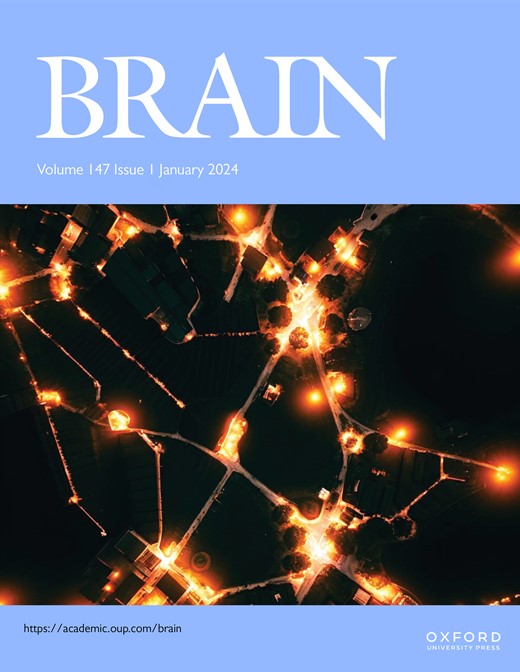High-resolution electrophysiological mapping of effective connectivity of lateral prefrontal cortex.
IF 11.7
1区 医学
Q1 CLINICAL NEUROLOGY
引用次数: 0
Abstract
The lateral prefrontal cortex (LPFC) serves as a critical hub for higher-order cognitive and executive functions in the human brain, coordinating brain networks whose disruption has been implicated in many neurological and psychiatric disorders. While transcranial brain stimulation treatments often target the LPFC, our current understanding of connectivity profiles guiding these interventions based on electrophysiology remains limited. Here, we present a high-resolution probabilistic map of bidirectional effective connectivity between the LPFC and widespread cortical and subcortical regions. This map is derived from intracranial evoked potential analysis of 48,797 intracranial direct electrical stimulation runs across 759 implantations in 724 patients with refractory epilepsy (368 male, 354 female, two unspecified; mean age 24±13.5 years). We mapped probabilistic connectivity between brain parcels with adaptive resolution - higher resolution in the LPFC in the hemisphere of interest and lower elsewhere - maintaining statistical power while achieving 95% average confidence interval of ∼0.03 for connectivity probability estimates. In addition, the significance threshold (p-value) for probabilistic connectivity was obtained from surrogate distributions. Overall, we observed remarkable symmetry between afferent and efferent connectivity patterns of the LPFC, with a slight preference for efferent connections (mean slope = 0.92±0.09, mean R² = 0.93±0.025). For example, connections between the inferior frontal gyrus (IFG) and anterior cingulate showed notable directional asymmetry. The IFG strongly projected to most brain networks compared to other LPFC regions, with the strongest connectivity to the ventral attention network (0.26±0.01 compared to values between 0.15 and 0.21 in other LPFC regions). Posterior DLPFC demonstrated stronger connectivity to brain networks compared to anterior DLPFC regions (eg. 0.21±0.01 vs 0.15±0.01 for connectivity to ventral attention network), with the exception of the limbic cortex. All LPFC subregions strongly projected to the fronto-parietal (greater than 0.17) and ventral attention (greater than 0.15) networks, with moderate connections to the default network (between 0.1 and 0.15, with the maximum corresponding to superior DLPFC). Finally, latency analysis suggested that the left LPFC's influence on ipsilateral emotion-related regions is primarily polysynaptic, with particularly strong pathways from IFG to amygdala (0.16±0.02) and hippocampus (0.12±0.01). Taken together, these comprehensive connectivity maps provide a new detailed electrophysiological foundation for understanding the functional anatomy of LPFC and guiding targeted brain stimulation protocols.外侧前额皮质有效连通性的高分辨率电生理作图。
侧前额叶皮层(LPFC)是人脑中高级认知和执行功能的关键中枢,协调大脑网络,其破坏与许多神经和精神疾病有关。虽然经颅脑刺激治疗通常针对LPFC,但我们目前对基于电生理学指导这些干预的连接概况的理解仍然有限。在这里,我们展示了LPFC与广泛的皮层和皮层下区域之间双向有效连接的高分辨率概率图。这张图来自于对724例难治性癫痫患者(368例男性,354例女性,2例未明确,平均年龄24±13.5岁)759次植入的48797次颅内直接电刺激的颅内诱发电位分析。我们以自适应分辨率绘制了脑包之间的概率连通性——感兴趣半球的LPFC分辨率较高,其他半球的分辨率较低——保持了统计能力,同时实现了连通性概率估计的95%平均置信区间为~ 0.03。此外,从代理分布中获得了概率连通性的显著性阈值(p值)。总的来说,我们观察到LPFC的传入和传出连接模式具有显著的对称性,并有轻微的传出连接偏好(平均斜率= 0.92±0.09,平均R²= 0.93±0.025)。例如,额下回(IFG)和前扣带之间的连接表现出明显的方向不对称。与其他LPFC区域相比,IFG强烈地投射到大多数大脑网络,与腹侧注意网络的连通性最强(0.26±0.01,而其他LPFC区域的值在0.15和0.21之间)。与前部DLPFC区域相比,后部DLPFC显示出与大脑网络更强的连通性。0.21±0.01 vs 0.15±0.01腹侧注意网络连接),边缘皮质除外。所有LPFC亚区都强烈投射到额顶叶(大于0.17)和腹侧注意(大于0.15)网络,与默认网络的连接中等(在0.1到0.15之间,最大对应于高级DLPFC)。最后,潜伏期分析表明,左侧LPFC对同侧情绪相关区域的影响主要是多突触性的,特别是从IFG到杏仁核(0.16±0.02)和海马(0.12±0.01)的通路特别强。综上所述,这些全面的连接图为理解LPFC的功能解剖和指导有针对性的脑刺激方案提供了新的详细电生理基础。
本文章由计算机程序翻译,如有差异,请以英文原文为准。
求助全文
约1分钟内获得全文
求助全文
来源期刊

Brain
医学-临床神经学
CiteScore
20.30
自引率
4.10%
发文量
458
审稿时长
3-6 weeks
期刊介绍:
Brain, a journal focused on clinical neurology and translational neuroscience, has been publishing landmark papers since 1878. The journal aims to expand its scope by including studies that shed light on disease mechanisms and conducting innovative clinical trials for brain disorders. With a wide range of topics covered, the Editorial Board represents the international readership and diverse coverage of the journal. Accepted articles are promptly posted online, typically within a few weeks of acceptance. As of 2022, Brain holds an impressive impact factor of 14.5, according to the Journal Citation Reports.
 求助内容:
求助内容: 应助结果提醒方式:
应助结果提醒方式:


